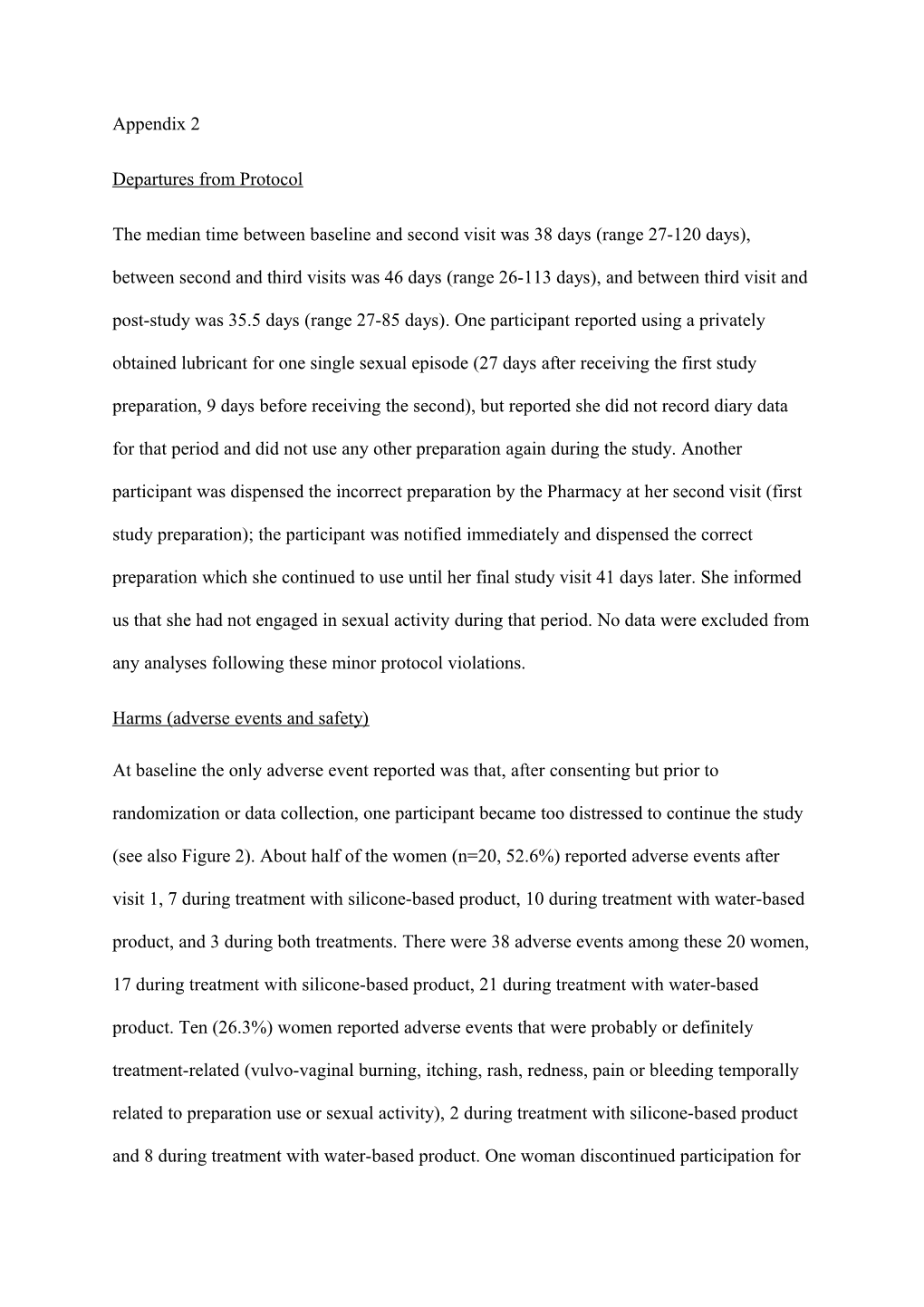Appendix 2
Departures from Protocol
The median time between baseline and second visit was 38 days (range 27-120 days), between second and third visits was 46 days (range 26-113 days), and between third visit and post-study was 35.5 days (range 27-85 days). One participant reported using a privately obtained lubricant for one single sexual episode (27 days after receiving the first study preparation, 9 days before receiving the second), but reported she did not record diary data for that period and did not use any other preparation again during the study. Another participant was dispensed the incorrect preparation by the Pharmacy at her second visit (first study preparation); the participant was notified immediately and dispensed the correct preparation which she continued to use until her final study visit 41 days later. She informed us that she had not engaged in sexual activity during that period. No data were excluded from any analyses following these minor protocol violations.
Harms (adverse events and safety)
At baseline the only adverse event reported was that, after consenting but prior to randomization or data collection, one participant became too distressed to continue the study (see also Figure 2). About half of the women (n=20, 52.6%) reported adverse events after visit 1, 7 during treatment with silicone-based product, 10 during treatment with water-based product, and 3 during both treatments. There were 38 adverse events among these 20 women, 17 during treatment with silicone-based product, 21 during treatment with water-based product. Ten (26.3%) women reported adverse events that were probably or definitely treatment-related (vulvo-vaginal burning, itching, rash, redness, pain or bleeding temporally related to preparation use or sexual activity), 2 during treatment with silicone-based product and 8 during treatment with water-based product. One woman discontinued participation for a treatment-related AE (vulval itching), and none for non-treatment-related AE. No serious AE were reported.
There were no differences between treatments or between baseline and final visit in physical signs of atrophy, including vaginal elasticity, apparent mucosal thickness, bleeding on examination, or vaginal pH.
For safety monitoring, the Hospital Anxiety and Depression Scale (HADS) questionnaire 1 was administered at each visit to screen for past-week anxiety and depression; women whose score in anxiety or depression reached the clinical cutpoint (≥ 11 1) were assessed to determine adverse event status, need for referral, and eligibility to continue the study. The GP was informed of any abnormal test results.
At baseline, 5 women (13.2%) met the screening cutpoint for anxiety, 1 (2.6%) for depression, and 2 (5.2%) for both. On consultation with the study psychologist, all were informed of the findings, screened by interview for clinically significant anxiety or depression, and their GP was informed. None required further treatment so were not excluded from the study.
At the second visit, 7 women (18.4%) met the screening cutpoint for anxiety (3 new from baseline), 2 (5.2%) for depression (0 new from baseline), and 1 (2.6%) for both (0 new from baseline). At the third visit, 4 (10.4%) women met the screening cutpoint for anxiety (1 new from baseline), 0 for depression, and 2 (5.2%) for both (1 new for depression but anxiety-positive at baseline). On consultation with the study psychologist, all were informed of the findings, screened by interview for clinically significant anxiety or depression, and their GP was informed. None required further treatment so were not excluded from the study.
Comparison to breast cancer patient norms
To compare baseline FACT scores to published scores for breast cancer patients 2, scores were recalculated per the instructions of the instrument publisher 3. A single item (GE6, “I worry that my condition will get worse”) was omitted from the scoring of the FACT-G and EWB, and 6.85, the average score for the now-omitted Relationship with Doctor subscale, added to the FACT-G. Similarly, to compare ES to the previously published norm based on an 18-item version (ES-18), we omitted a single item (BRM1, “I have pain in my joints”). Scores were compared using standardized mean differences calculated using Hedges’ g 4.
Endocrine symptoms were substantially lower (worse) for our participants than for published norms for breast cancer patients (whole-group ES-18 mean 45.1, SD 10.9; normative mean 59.7, SD 9.2, Hedges’ g=-1.55) 2. As expected for this clinical trial, on examination of individual components of the ES, scores for our participants were below the scale midpoint (more severe) for vaginal dryness, pain or discomfort with intercourse, loss of interest in sex, and hot flashes. Physical well-being was slightly lower than published norms (whole-group PWB mean 21.2, SD 5.1; normative mean 23.8, SD 4.9, Hedges g=-0.44), contributing to a slightly lower than normative general well-being score (whole-group FACT-G mean 85.0, SD 14.01, normative mean 90.8, SD 14.1 Hedges’ g=-0.41). At baseline, social/family well-being, emotional well-being, functional well-being and breast cancer-related quality of life did not differ substantially from published norms for breast cancer patients.
1.Zigmond AS, Snaith RP: The hospital anxiety and depression scale. Acta Psychiatr Scand 67:361-70, 1983
2.Fallowfield LJ, Leaity SK, Howell A, et al: Assessment of quality of life in women undergoing hormonal therapy for breast cancer: validation of an endocrine symptom subscale for the FACT-B. Breast Cancer Res Treat 55:189-99, 1999
3.Cella D: Manual for the Functional Assessment of Chronic Illness Therapy (FACIT) Measurement System. Elmhurst, IL, facit.org, 2012
4.Hedges LV: Distribution Theory for Glass's Estimator of Effect size and Related Estimators. Journal of Educational and Behavioral Statistics 6:107-128, 1981
